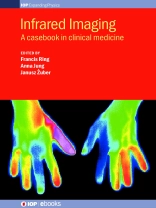Infrared thermal imaging is a rapid and non-invasive procedure for mapping skin-temperature distribution of the human body. Advanced software and high-resolution infrared detectors has allowed for a renaissance in the use of infrared thermal imaging or thermography in medical research and practice. After a review of theory, technology and methodology of medical infrared imaging, the remainder of the book consists of a collection of clinical case studies demonstrating the wide variety of applications of thermography in modern medicine. The combined expertise from a number of centres is used to create this database of images and cases that will be invaluable for medical researchers and practitioners in making diagnoses and measuring treatment efficacy. This book is recommended reading for practising and training radiographers, medical physicists and clinicians.
Mục lục
Preface xiii
Acknowledgements xiv
About the editors xv
List of contributors xvi
Part 1 Technical
1 The technique of infrared imaging in medicine
2 The reproducibility of standard positions used for image capturing within the standard protocol for thermal imaging
3 The reliability of temperature readings from selected standard views for thermal imaging
4 The influence of colour scale on the accuracy of infrared thermal images
Part 2 The head and neck
5 New standards for fever screening with thermal imaging systems
6 Infantile haemangiomas—IR thermography in assessment
7 Exploratory thermal and laser speckle contrast imaging measurements of eye inflammation in a case of thyroid eye disease
8 Thermographic examination of a boy with an abscess near to the maxillary sinus
9 Malignant melanoma characterization with thermal and visual imaging
10 Thermographic monitoring of ophthalmic surgery—extraction of a cataract
11 Application of thermal imaging in the diagnosis of inflammatory changes of nasal sinusitis
12 Thermal evaluation of the temperature distribution in the oral cavity during dental operations
Part 3 The trunk
13 Thermographic assessment of the presence of fatty tumours in myoclonic epilepsy with ragged red fibres
14 Tietze’s syndrome and the role of infrared imaging in the differential diagnosis of acute chest pain in adolescents
15 Thoracic vertebral block—the technique of injecting local anaesthetic
Part 4 The upper extremities
16 The sensitivity of infrared imaging for diagnosing Raynaud’s phenomenon is dependent on the method of temperature extraction from thermal images
17 Nerve entrapment and skin temperature of the human hand
18 Imaging assessments of patients with suspected systemic sclerosis and associated inflammatory lung disease
19 The use of infrared thermography to differentiate ‘cold intolerance’ from ‘true Raynaud’s phenomenon’ in the context of fibromyalgia
20 Hand arm vibration syndrome documented by thermal imaging—a case report
21 Thermal imaging and its potential for arterio-venous fistula function assessment
22 Thermographic monitoring of blood flow in arterio-venous fistulas
Part 5 The lower extremities
23 A case study in the diagnosis of a grade III ankle sprain using a combination of medical images
24 Thermal imaging in the monitoring of grade III ankle sprain rehabilitation—a case study
25 Application of thermal imaging in the diagnosis and treatment monitoring of complex regional pain syndrome type I
26 The thermal imaging potential for assessing diabetic Charcot foot syndrome
27 Thermal imaging of the foot in different forms of diabetic disease
28 Thermal imaging in the screening diagnosis of crural varices in adolescents
29 Thermographic investigation in the diagnosis of femoral vein thrombosis
30 Infrared thermal imaging of critical leg ischaemia
31 Infrared imaging of angiomatosis syndrome (Klippel–Trénaunay syndrome)
32 Thermal imaging: a monitoring tool for the treatment of erythromelagia
Giới thiệu về tác giả
Francis Ring is a pharmacologist and clinical scientist with 50 years’ experience in quantitative infrared thermal imaging in medicine. He currently leads the Medical Imaging research Group at the Faculty of Advanced Technology, University of Glamorgan, UK, and has published more than 300 papers in this area.
Anna Jung is Professor of Paediatrics and Nephrology at the Military Institute of Medicine in Warsaw, Poland, and is experienced in the application of thermographic methods in paediatric diagnostics and has twice served as the President of the European Association of Thermology.
Janusz Żuber is a specialist physician in allergic medicine at the Military Institute of Medicine in Warsaw, Poland, with many years’ experience of applications of thermography and thermovision in allergology and other branches in medical diagnostics.












